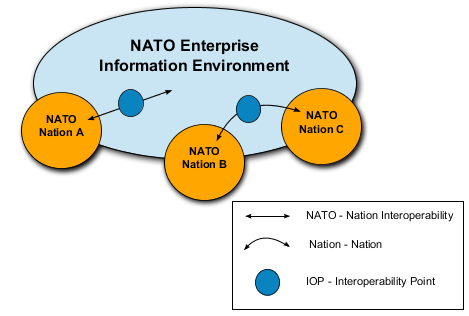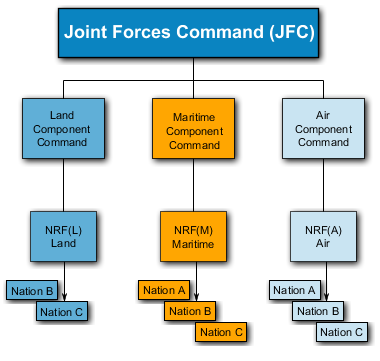B.2. Background
B.2.1. The Changing Face of NATO
88. In today’s NATO, an increasing number of operations are being conducted outside of traditional missions. NATO response is not restricted to war, and have grown to encompass humanitarian and peacekeeping efforts.
89. In addition to shifting mission scopes, NATO’s area of operations is also expanding, discarding traditional European geographic constraints. NATO operates an International Security Assistance Force (ISAF) in Afghanistan; in Darfur NATO is assisting the African Union (AU) by providing airlift for AU peacekeepers; relief efforts in Pakistan consisted of NATO-deployed engineers, medical personnel, mobile command capabilities, and strategic airlift. Additionally, these efforts have been repeated in support of operations in Iraq.
B.2.2. Information Exchange Environment
90. The figure below characterizes the information environment and various scenarios that exist for exchanging operational information. This environment, although rich in participation and basic connectivity, lacks fully meshed interoperability at the services layer. This diagram represents today’s environment, and the starting point for development of NRF interface profiles. It is presumed for the purposes of this document that NRF profiles will only address capabilities between NATO and NATO Nations in various interconnecting arrangements (NATO-NATO, NATO-NATION, and NATION-NATION) The operational environment gives us many combinations of connections and capabilities for consideration.
B.2.3. NATO Response Force (NRF)
91. The NRF will be a coherent, high readiness, joint, multinational force package, technologically advanced, flexible, deployable, interoperable and sustainable. It will be tailored as required to the needs of a specific operation and able to move quickly to wherever it is needed. As such, the NRF will require dynamic and deployable CIS capabilities adept at integrating with other NATO and national systems.
92. As outlined in NATO Military Committee Directive 477 (MC477), the NRF will be able to carry out certain missions on its own, or serve as part of a larger force to contribute to the full range of Alliance military operations. It will not be a permanent or standing force. The NRF will be comprised of national force contributions, which will rotate through periods of training and certification as a joint force, followed by an operational “stand by” phase of six months. Allied Command Operations (ACO) will generate the NRF through force generation conferences. ACO will be responsible for certification of forces and headquarters.
93. The NRF will also possess the ability to deploy multinational NATO forces within five days anywhere in the world to tackle the full range of missions, from humanitarian relief to major combat operations. Its components are to be tailored for the required mission and must be capable of sustainment without external support for one month.
B.2.4. NRF Command Structure
94. Connectivity for NATO forces are based upon a force military structure, with subordinate ad hoc task force headquarters to include Combined Joint Task Forces and the NATO Response Force.
95. NATO is responsible for providing extension of the secure connectivity to the highest level of a national or multinational tactical command in a theatre of operations. Nations are generally responsible for the provision of their own internal CIS connectivity. This dynamic information environment often employs disparate solutions to meet similar requirements, depending on the capabilities of interconnecting entities. For this reason a modular approach to development of interface profiles is intended to provide a template to interoperability and reuse.
96. The figure below depicts a generic C2 structure applicable to the NRF, with profile products aligning to the following NRF Command Structure for connectivity between elements of this command hierarchy.
B.2.5. Requirement
97. The NRF MMR states the requirement for a common, or at least compatible, type of modular or scaleable NRF capability autonomous from the CJTF capability.
98. These are relevant Minimum Military Requirement for an NRF that are applicable to this document and the profiles within:
-
Only involve NATO nations (as opposed to a full CJTF scenario),
-
Be derived from a NATO Response Force Package (that will be pre-designated and put under standby stage on a rotational cycle), and
-
Be tailored to a specific operation as required.
99. NATO DCIS will be capable of meeting the secure and non-secure information exchange requirements of the deployed HQs while providing a meshed network integrating the Strategic, Operational, and Tactical levels of command.
100. As a result, NRF capability packages should consider the following characteristics:
-
Be Technologically Advanced & Interoperable,
-
Be Flexible (in terms of format and operational mission to be fulfilled),
-
Be Rapidly Deployable under short notice (typically less than 30 days),
-
Be Self-Sustainable for 30 days,
-
Be Capability Orientated (as opposed to threat oriented), and
-
The following capabilities are typically required, Surveillance, Lift, Electronic Warfare and NBC.
101. To meet the Technologically advanced characteristic, NRF DCIS capabilities will provide voice and data services to authorized NATO and non-NATO users; provide access to linked information databases supporting the Common Operational Picture; and access to Functional services and user Information technology tools. Sufficient connectivity is required to provide a robust reachback capability for the DJTF and component command HQs to meet necessary information exchange requirements. The focus of this effort is to meet the requirement for NRF Interoperability through the development of interface profiles.
B.2.6. NRF CIS Challenges
102. The rotation of nations responsible for NRF component commands, and the challenges of forced entry in out of area operations, provides CIS interoperability challenges, while at the same time, providing a platform to regularly test systems interoperability and refine operational processes and procedures. Preplanning for NRF rotations requires active involvement of the NRF planners up to 2 years prior to a rotation date, and due to churn of nations and commands, a template for standardizing the process and sharing lessons learned should ease this process.
103. The process established is for 6 month pre-deployment of an NRF, followed by a 6 month operational ready stage. The use of profiles will support the NRF Notice to Move requirement of 5-30 days readiness. The deployed JTF HQ will be at 5 days notice to move. The intent of the NRF interface profile is to proactively harmonize interoperability issues during NRF rotations in the pre-deployment period and in the preparation period, without hindering the Notice to Move requirement, or minimizing the technology capabilities in support of NRF Command and Control.
104. As NRF resources (or “force packages”) are provided by NATO and nations on a rotation basis:
-
NRF headquarters (HQ) is provided by a NATO regional joint force command (JFC),
-
Component Commands are provided
-
by the NATO nation(s) for the Land component command (LCC) and Maritime Component Command (MCC) or
-
by NATO for the Air component command (ACC).
-
105. This document provides further guidance for establishment of the interfaces for NATO nations. Additionally, consistent implementation of solutions in accordance with defined parameters will enable host nations to interface, but also, other nations that are supporting the NRF effort. The intent is to enhance the operational environment by enabling sharing of information, enriching service availability, and blending the tactical, operational, and strategic environments.

